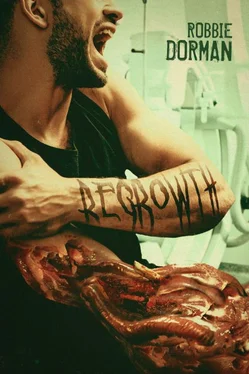Jon slid the syringe into the rat and injected the material. It wasn’t a lot. It didn’t need to be. CRISPR technology had advanced a lot since its inception, and Shaw had pushed it even further. Changes to the genome could take days or weeks before. Now it was minutes. Shaw hadn’t been kidding when he said he wanted change quickly.
And within minutes, the regrowth had started. Blood loss had slowed, and then stopped, and the arm regrew in front of their eyes. The IV drip was nutrient rich, trying to give the rat as much fuel as they could, to burn for the pyre that was churning near its severed arm.
But it was still slow. Incremental. Within a few minutes, the regeneration slowed even further.
“We’ve burnt through all its reserve,” said Jon. “At least the safeguards are working. It’s not stealing from the muscle tissue in the rest of the animal. Now it can only heal as quickly as we deliver the nutrients through the IV.”
“How long will it take?” asked Mel.
“I don’t know,” said Jon. “Probably hours, at this rate. We can start a few others, with different serum models and other delivery methods for CRISPR. See if there’s any change.”
They worked hard, and in sequence, they repeated the procedure. Sedating a rat, amputating its arm, and then injecting a different serum into it, wondering if any of the results would be different, more or less effective, faster, slower, more efficient. They measured hundreds of variables, and soon all their space was filled with a half dozen rats, all sedated, all slowly regenerating limbs.
“A watched pot never boils,” said Jon, as Mel stared at them, her eyes glued to the different rats.
“I shouldn’t have named them,” said Mel.
“Every day is a learning experience,” said Jon. “The next batch you’ll know better.”
“What do you mean, the next batch?” asked Mel. “What if one of these is a winner?”
“I appreciate your optimism,” said Jon. “But I’m not holding my breath. In my experience, if you can glean anything positive to move forward with from the first set of tests, you’ve done well. But none of these will be a final serum, even for the rats.”
Mel sighed and pressed her lips together.
“You should probably just do other work,” said Jon. “We can check back throughout the day.” Mel nodded, and went back to her workstation, and soon her mechanical keyboard clacked like a machine gun.
Jon tried to do the same, but found it hard to follow his own advice. He wanted to remain optimistic as well, that somehow with all the advanced Shaw tech, they would stumble onto a breakthrough right away. That the results, although slow, would work, and they could move onto a larger animal for the next round of testing. That Shaw’s goals weren’t ridiculous. That human results would be tangible in the near future.
Jon stole glances at the rats as the day wore on. After hours, he forced himself back to his station, to plan for the next day, and the next week. He let his mind wander, to Tommy, to Maya, to Tabby, still blankly staring at the screen, full of contingencies and possibilities to explore with the subsequent set of modeling.
Was Maya doing okay up top? She was the most dependable person he’d ever met, one of the mentally toughest, one of the reasons he had fallen in love with her. Her tenacity and willpower had impressed him more than anything. It was always something he had struggled with, and he had admired it in her.
She’s doing fine. She’s contributing. Hell, even if they shut the hospital down, she’d probably do triage work in her living room. But nothing could stop her.
“Jon!” said Mel, and her sudden voice broke him out of his thoughts. He looked to her. She must have been trying to get his attention.
“Sorry,” he said. His eyes flitted to the clock on his screen. Oh shit, results. He had lost track of time. The rats would be finished regenerating by now.
“What do they look like?” asked Jon, only able to see Mel’s face, not yet the rats. He thought her face told him all he needed to know. Failure. He had expected it to be fair, but he always hoped for success, even minimal success. He got up and walked over to see the results for himself.
Mel’s expression hadn’t prepared him.
He had expected half formed limbs, or the wrong number of fingers, or arms that didn’t function at all. Unacceptable mutations, and certainly unpleasant to look at, but it was a spectrum of failure he had prepared himself for, especially in his field of research. Anyone who had studied biology had dissected numerous animals and seen lots of violence inflicted on them. And in his study, he’d seen hundreds if not thousands of pictures of amputees, of battle trauma, of victims of car accidents and construction mishaps. Ghastly things, that after enough exposure, had desensitized him to a certain extent. He didn’t know how Mel worked, but he had assumed the rats would have some level of deformation.
He hadn’t expected this. None of the six rats looked identical, but all of their regrown limbs had mutated. But they weren’t half formed. If anything, they were over grown. The limbs had grown bulbous, red, inflating with muscle, and fat, and bone. Some had bone spikes poking through their skin, where they leaked blood. Others had sets of multiple paws, all in a row next to each other. One in particular had a limb cartoonishly long, twice as long as a normal limb, thick with disgusting muscle, impossible and distended. It twitched, and he felt a twinge in his gut, and he averted his eyes for a second, taking a deep breath.
But he looked back.
“What should we do?” asked Mel.
“Record results,” he said. “On every animal, and then we euthanize them. I’ll dissect them.”
Mel looked at him, and then back at the animals, and then she broke, holding a hand over her mouth, and running to the trash can. She threw up, her hands holding the can tight to her face. She finished, spitting a few more times. She tentatively put it down and went to her desk, drinking from a bottle of water.
“I—I wasn’t ready for—whatever this is,” said Mel.
“You’re doing a good job,” said Jon. “But next time, be ready. Because we will see worse.”
Mel nodded and retrieved her notebook and prepared the vials of euthanizing agent. It would kill them quickly and painlessly. Jon readied for dissection.
Jon knocked on the door, feeling halfway silly. Here he was, in Star Trek land, and he was knocking on doors. But he didn’t know what else to do. He felt a pit in his stomach that no amount of deep breathing could banish.
It’s just dinner, you dummy. You’ve eaten lunch with her dozens of times at this point.
But it wasn’t just dinner. It was a date. And putting that label on it had made the easy context of a conversation over a meal feel like summiting Mt. Everest.
It had been a few weeks since the first experiment, and they had found little positive in their research in the intervening time. They had repeated experiments on dozens and dozens of rats, with various permutations of the serum, over and over again, but no matter which version they used, the rats came out wrong. The mutations and deformities continued. His work hours had stretched longer and longer. He still ate lunch with Tabby every day, and his admiration of her had grown into a full on crush.
Still, he didn’t ask her out. He didn’t know what was considered appropriate here. They were colleagues, but he had his hands full with his research, so he would let their friendship remain just that.
Until Tabby asked him over for dinner.
“Do you want to come over tonight?” she had asked. His heart jumped a little at the question. He almost choked on his sandwich. He had to force it down, taking a big swallow of water.
Читать дальше












